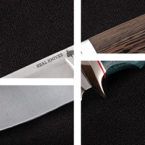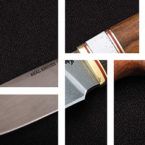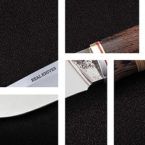Real Knives are for real work.
That’s our motto.
That’s also the kind of knives we offer. Forged, hand made. Designed by great professionals. Professional practitioners who also use them in extreme environments.
Our knives are real companions – in adventure as well as hard work. The ones you can really rely on.
You must have a reliable knife, while being alone in the woods, tundra, taiga or bush. You can survive without a rifle, binoculars or other equipment. Without water and knife you can’t.
That’s are our knives. Reliable and great hunters like their namesakes:
Panthera, Irbis, Lynx, Lampart, Jaguar, Gepard, Ocelot, Caracal.
Steel we have chosen for your knives is also unique.

Almazka, commonly referred to as diamond steel due to its high strength and hardness. It owes its composition. HW5 belongs to steel with a high content of tungsten and chromium, its primary use is medical instruments, jewelry tools, metalworking cutters. The legend of diamond steel was formerly obtained because of the wide use by jewelers to create various tools for processing precious stones.
The diamond steel knife is reliable, practical and has high blade hardness. Maintains sharpens for a long time. It’s great for cutting skin, meat, tendons or even bones. If necessary, it can cut, without much effort, wire, nails or sheet metal. However, this knife should not be thrown or subjected to strong stresses when prying or twisting. It’s simply not used for this. Its element is cutting and cutting.
Extremely sharp and hard steel.

Bulat/Wootz – for around 2,300 years it should have been called real Damascus steel, characterized by excellent utility values (pulad in Persian and bulat in Russian). Also known as crystalline damast. Currently, incorrectly, commonly known as Damascus steel damasta forged or a freak. However, the difference between them is fundamental. The bulat is created by smelting and forging, and the freak “only” by forging various layers of steel.
Bulat, as we have already mentioned above, is produced by smelting and then forging. Thanks to this, iron carbides are formed in the structure. Carbides have a much higher hardness than carbon steel alone. The presence of carbide domains allows forging and sharpening the weapon that the blade is very hard and not chipped, while maintaining the flexibility of the entire blade. The addition of chromium, molybdenum and vanadium strengthens these properties and makes our knives highly resistant to weather conditions.
Legendary steel with legendary properties
In the 3-2 century BC, near India/Pakistan, local blacksmiths after many attempts discovered a new way of producing great quality high-carbon steel. By adding certain types of glass to the local iron ores a very high purity of the alloy was obtained. This technology along with the development of trade and movement of the population reached around the tenth century in the Middle East. Further experiments with local ores and various admixtures of glass allowed to achieve a phenomenal product for those times. Rare, desirable and very expensive. The steel structure has iron carbide domains that form a dendrical arrangement of layers and ribbons that are parallel to each other. This allows forging that the carbide strip is on the blade and the parallel layers and subsequent bands are becoming less dense as the distance from the cutting edge. Very high hardness, chipping resistance while maintaining flexibility. Iron carbides have a much higher hardness than carbon steel alone. Such properties are ideal for knives and cutting weapon, and by the way the Bulat pattern on the blade is beautiful with a characteristic discreet charm. Currently, due to the workload, complexity and knowledge, technology is being reproduced in few places around the world.
It’s steel for the best and most expensive knives.
It’s a real knife, resistant and resilient. BULAT is tempered to 63 HRC. It serves long and faithfully.
Working with knives made of this steel is a great pleasure.

Forged damasc, pattern welding, is a type of steel resulting from repeated forging of mild steel with low carbon content, with hard steel with high carbon content. The difference in carbon content must be significant for the characteristic pattern to become visible.
Our knives are forged from over 1000 layers of steel (among others SHK15 and HVG), thanks to which they have unique usability. Hardening up to 62 HRC allows for long and smooth work without frequent sharpening.
The hard, high-carbon part is for sharpness, the soft, low-carbon part for flexibility.
Beautiful steel.

H12MF is an alloy tool steel with high chromium content. Knives made of forged steel H12MF (analog to D2) are believed to be one of the best choices for hunters and anglers. Knives made of this steel have high abrasion resistance and durability while maintaining hardness and aggressive cutting.
According to hunters, the forged knife of H12MF steel easily copes with two moose, without sharpening.
Our knives have 62 HRC sharpness. It’s the perfect choice for a real knife for many tasks with great cutting characteristics. The high chromium content means that steel does not catch rust, so with minimal care it will serve for a long time and with dedication.
Faithful steel.








